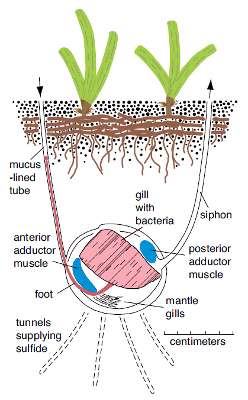Symbiotic survival

One of the most diverse families in the ocean today—marine bivalve mollusks known as Lucinidae (or lucinids)—originated more than 400 million years ago in the Silurian period, with adaptations and life habits like those of its modern members. This Geology study by Steven Stanley of the University of Hawaii, published online on 25 July 2014, tracks the remarkable evolutionary expansion of the lucinids through significant symbiotic relationships.
At is origin, the Lucinidae family remained at very low diversity until the rise of mangroves and seagrasses near the end of the Cretaceous. According to Stanley, the mangroves and seagrasses created protective habitats in which the bivalve mollusks could thrive, in turn providing benefit through a sort of tri-level symbiosis.
Stanley writes that what was especially important was the lucinids' development of a symbiotic relationship with seagrasses. The lucinids flourished as they took advantage of the oxygen-poor, sulfide-rich sediments below roots and rhizomes. These habitats provided a rich supply of sulfur-oxidizing bacteria (or endosymbionts), which the bivalves "farmed" on their gills and then consumed. At the same time, the seagrasses benefited from the uptake of (to them) toxic sulfide by the bivalves.
The Cretaceous mass extinction, which killed off not only the dinosaurs but also many forms of marine life, had little impact on the lucinids. Stanley writes that this can be attributed to the fact that the bivalves relied heavily on the endosymbiont bacteria for nutrition at a time when productivity of marine algae collapsed and many suspension-feeding groups of animals died out. About 500 lucinid species exist today, with by far the highest diversity in shallow-sea seagrass meadows.
More information: Evolutionary radiation of shallow-water Lucinidae (Bivalvia with endosymbionts) as a result of the rise of seagrasses and mangroves, Steven M. Stanley, Geology, Published online 25 July 2014; dx.doi.org/10.1130/G35942.1
Journal information: Geology
Provided by Geological Society of America




















